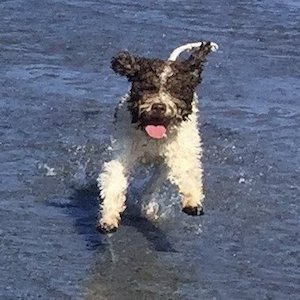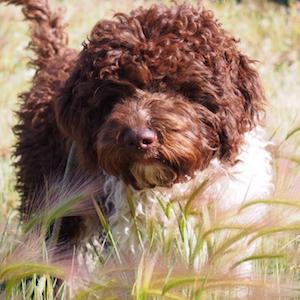Lagotto Health
Getting a Puppy
Although there are no guarantees when working with Mother Nature, there are certainly a great number of steps we can take to ensure that you are starting off on the right foot. There are a number of organizations throughout the world which specialize uniquely in canine health and preserving genetic diversity.
Questions for your potential breeder
-
01
Coming soon…
-
02
Coming soon…
-
03
Coming soon…
-
04
Coming soon…




Genetic Diseases
Benign Familial Juvenile Epilepsy
Research has shown that puppies affected with Juvenile Epilepsy may experience seizures of differing severity beginning at 5 to 9 weeks of age and usually resolve by 8 to 13 weeks. Some affected pups will show no physical symptoms. There have also been a few reported adult-onset cases. In the most severe reported cases, affected dogs developed other neurologic signs such as generalized ataxia and hypermetria.
Pedigree analysis suggests an autosomal recessive mode of inheritance to this gene. It is therefore recommended that any breeding dog carrying a mutation of this gene only be bred to partners who are free of the mutation.
Please see the information provided by Genoscoper for more details.
Lysosomal Storage Disease
Lysosomal Storage Disease is a progressive neuro disorder. Please see the information provided by Genoscoper for more details.
Neuroaxonal Dystrophy
Neuroaxonal Dystrophy is a neurodegenerative disorder. Please see the information provided by Genoscoper for more details.
Please note that Neuroaxonal Dystrophy (NAD) is not yet clinically verified.
Hyperuricosuria
Hyperuricosuria is a disorder which predisposes affected dogs to stones of the kidney and bladder. Please see the information provided by Genoscoper for more details.
Autosomal RecessiveMode of Inheritance Chart
-
Normal
-
Carrier
-
Affected
-
Normal
-
All Puppies Normal
-
Some Puppies CarrierSome Puppies Normal
-
All Puppies Carrier
-
Carrier
-
Some Puppies CarrierSome Puppies Normal
-
Some Puppies AffectedSome Puppies CarrierSome Puppies Normal
-
Some Puppies AffectedSome Puppies Carrier
-
Affected
-
All Puppies Carrier
-
Some Puppies AffectedSome Puppies Carrier
-
All Puppies Affected
Please note that the Lagotto Romagnolo Club of Canada only recommends the mating of 2 normal dogs or the mating of one normal dog to one carrier dog.
Hip Dysplasia Stats
Lagotti Scoring OFA Excellent
Lagotti with Passing Hips
Lagotti with Dysplastic Hips

The International Rating Scale for hip dysplasia utilizes hip scores of different rating scales from different countries and places the scores using a common rating of “A” through “E”, “A” meaning no evidence of hip joint deformity and “E” meaning radiographic hip dysplasia is evident.A distinction can be made between radiographic hip dysplasia where the radiographs indicate joint changes or deformities but the dog displays no symptoms of the disorder, and clinical hip dysplasia where the dog exhibits symptoms such as stiffness and discomfort at a young age.
The most common cause of hip dysplasia, whether environmental or genetic, is currently a topic of debate. Factors such as excess weight, poor diet and over exercising a dog are known to be common environmental factors that can cause wear and tear. In many dogs, evidence of hip dysplasia seen on a radiograph will never develop into clinical hip dysplasia whereas dogs with genetically better hips may develop the disorder based on environmental factors.
Although historically, clinical hip dysplasia was not a common disorder in the breed, the disorder is becoming more prevalent. The Lagotto Romagnolo Club of Canada requires that breeders test the hips of their breeding stock prior to breeding in order to properly assess the health of their dogs and to aid in the selection of a proper breeding mate, and require that only dogs receiving a score of A through C using the International Rating Scale are eligible for breeding programs.
Breeders are encouraged to study and analyze the pedigrees of each of their breeding dogs to aid in a successful pairing for all breedings.
Patellar Luxation is a condition where the kneecap pops out of place. Bilateral cases are most common (meaning both kneecaps pop out of place), however unilateral (only one of the two kneecaps) presentation can also be somewhat common. Puppies can be affected by the time they reach 8 weeks of age.
The OFA rating scale for patellas is as follows:
Grade 1
The patella easily luxates manually at full extension of the stifle joint, but returns to the trochlea when released.
Grade 2
There is frequent patellar luxation which, in some cases becomes more or less permanent.
Grade 3
The patella is permanently luxated with torsion of the tibia and deviation of the tibial crest of between 30 degrees and 50 degrees from the cranial/caudal plane.
Grade 4
The tibia is medially twisted and the tibial crest may show further deviation medially with the result that it lies 50 degrees to 90 degrees from the cranial/caudal plane.
